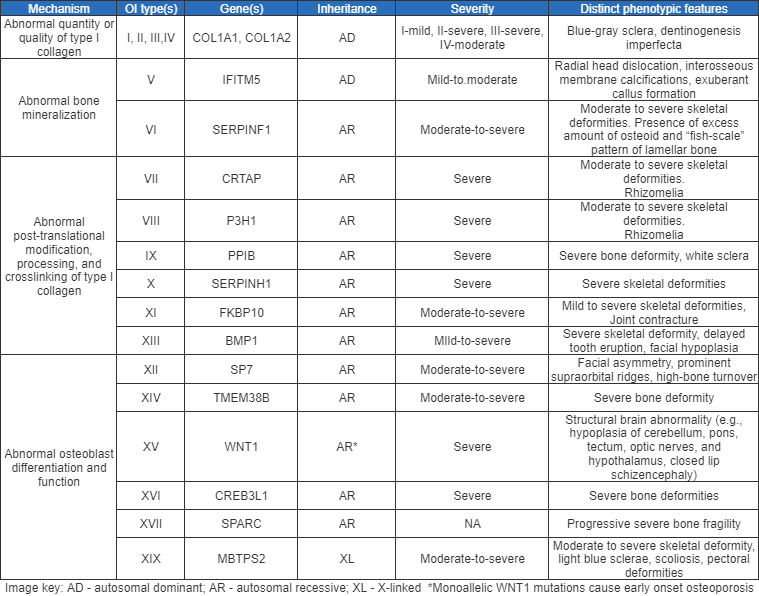Etiology
OI is a Mendelian disorder that is genetically heterogeneous. OI can be caused by pathogenic variants in numerous genes which have pivotal roles in the synthesis, post-translational modification, processing, and assembly of type I collagen, bone mineralization, and normal differentiation and function of osteoblasts (bone forming cells). Mutations of COL1A1 and COL1A2 genes, which encode for alpha 1 and alpha 2 chains of type I collagen, are most commonly implicated.[1][8][9][10][12]
Pathophysiology
The underlying pathophysiologic processes accounting for the vast majority of OI cases involve abnormalities in the quantity or quality of type I collagen.[8][9][10] Less commonly, genetic defects lead to abnormalities in bone mineralization and osteoblast function.
Up to 90% of all OI is caused by pathogenic variants in COL1A1 and COL1A2 genes, which encode for alpha 1 and alpha 2 chains of type I collagen, the major component of bone matrix.[8][9][10]
Nonsense variants, frameshift and splice site variants that lead to premature termination, and whole gene deletions involving COL1A1 or COL1A2 result in a quantitative defect (i.e., reduced amount of structurally normal type I collagen); such variants are typically associated with a mild, nondeforming phenotype (OI type I).
Missense variants in COL1A1 or COL1A2 that affect glycine residues of Gly-X-Y repeats in the triple helical domain of type I collagen lead to qualitative defects (i.e., structurally abnormal type I collagen that is typically associated with more severe forms of OI [types II, III, and IV]). Qualitative defects in type I collagen can result in prolonged retention and excessive modification of type I collagen within the endoplasmic reticulum of osteoblasts, increased endoplasmic reticulum stress, autophagy, and apoptosis. In general, mutations in COL1A1 cause more severe phenotypes than mutations in COL1A2, and missense glycine substitutions in the carboxyl-terminal portions of the triple helix cause more severe phenotypes than similar mutations in the amino-terminal portions of the protein.[13][14][15][16]
Pathogenic variants in genes that result in abnormal post-translational modification, intracellular trafficking, assembly, or crosslinking of type I collagen cause decreased bone mass, altered biomechanical properties of bone, and increased bone fragility observed in autosomal recessive forms of OI (OI types VII-XII).[1][4][17][18] Furthermore, structurally abnormal collagen in the extracellular matrix can lead to dysregulated signaling in the bone matrix that can alter bone remodeling resulting in low bone mass and decreased bone strength. Evidence from several studies suggests that bone is hypermineralized in OI.[19][20] Type I collagen is also a major component of many tissues including tendons, ligaments, and lungs, and therefore people with OI can have extraskeletal manifestations.
OI types V to XXIX are not caused by abnormal structure or function of type I collagen but by pathogenic variants in genes that affect bone mineralization (OI types V and VII) and differentiation and function of osteoblasts (OI types XII, XIV, XV, XVI, XVII, and XXIX).[21][22][23][24][25][26]
Classification
Sillence classification[3]
OI is clinically categorized into four types based on phenotypic severity. This classification, originally proposed by David Sillence before the genetic basis of OI was known, is still used today.
The Sillence types of OI are:
Type I: mild, nondeforming (fewer fractures, absence of major bone deformities, blue sclera)
Type II: severe perinatal (multiple fractures, hypomineralization of bones, multiple bone deformities, blue sclera, dentinogenesis imperfecta, typically lethal in the infantile period)
Type III: progressively deforming (multiple fractures, multiple bone deformities, "popcorn" epiphyses, blue sclera, dentinogenesis imperfecta)
Type IV: moderately deforming (multiple fractures, gray or white sclera, dentinogenesis imperfecta).
OMIM genetic classification
With the rapid discovery of new genes that cause OI, an alternative genetic classification, comprising more than 20 types, has been defined in Online Mendelian Inheritance in Man (OMIM). Online Mendelian Inheritance in Man (OMIM) Opens in new window
[Figure caption and citation for the preceding image starts]: Genetic classification of osteogenesis imperfectaMarini, J, et al. Nat Rev Dis Primers 3, 17052 (2017); used with permission [Citation ends].
Use of this content is subject to our disclaimer